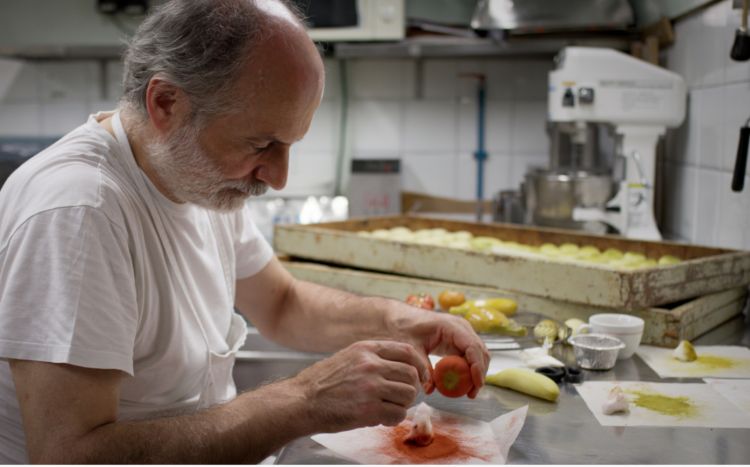«We’ve decided to open next year directly. We aim to do so before Easter, perhaps already on April 1st 2021. What’s sure is that until then Caffè Sicilia will not open to the public». Corrado Assenza is as calm as usual as he announces an important decision. Let’s see why.
What are the reasons of this extended closing?
This year we were ready to open on the 13th March, but then on the 8th it went as we all know. We stopped at the last moment, and started to think. We already wanted to renovate the place to better handle the post-Netflix impact, which was big. Given the uncertainties of the moment, we decided to do so in one sole time, instead of spreading the works on and off over two years. So we’ll do better and we will be better equipped for the future, in the hope that in the meantime humanity will have found the way to coexist more serenely with the virus.
Is the decision also connected with the arrival of tourists?
Of course. Noto lives on tourism. These days the historic centre is deserted, while the suburbs are lively. Caffè Sicilia is in the heart of town, in a pedestrian area, and therefore is affected by all the criticalities of this moment. All the hospitality structures in the village, from bed & breakfasts to small hotels and countryside inns, have had their bookings cancelled. Some have been so daring as to keep those in July and August but, for sure, we’re very far from the large numbers that we need for our work to be profitable.
What will the new Caffè Sicilia be like?
In general we hope to preserve the simplicity we have always evoked and put into practice. We will try to enhance even more the perception of the pure raw materials that come from our hands and arrive to the palate of the consumer. In the area open to the public, we will change the furniture, the windows, the counters and the spaces behind the counters. But the largest job will be in the production area, for those who work here. The lab will be deeply renovated, even visually. But we want to preserve the atmosphere one usually experiences inside.

Corrado Assenza at work with frutta martorana (photo Brian McGinn)
What sort of atmosphere?
Usually, when clients arrive they have two reactions: some are disappointed, some are pleased. Those disappointed expected a large international bar, built according to the current fashion: when they arrive at Caffè Sicilia, they think it’s overrated. Then there are those who are pleased to notice it’s a very different place from everything else, that it has a strong personality because it’s a real, authentic place, the result of fascinating solutions in style that were added over the years, for the past 130 years. We will try to preserve this spirit.
When you will open again, will more people work here?
When we were running fully, last year, we were 22, plus two more people in the office. It would be already great to keep the same number of people in April 2021.
With the new structure, will you also add new lines or products?
Most of all, we will rationalise the production flow. And we will be better equipped to run the online shop, which we just launched.
Will the products of Caffè Sicilia be available for shipping?
Yes, we will start with those that can stand the journey, that is to say all those kept in jars: jams, marmalades, nut creams, Mielarò aromatise honey, torrone. And the biscuits made with almonds, the dry cakes, the cookies …

Cassatina siciliana from Caffè Sicilia. Come this autumn, we will also be able to have it to take away (photo Brian McGinn)
It would be a dream to receive the fresh products too.
It’s a complex business. We’re making tests because there is no refrigerated shipment service for small packages. It’s us who need to refrigerate the packaging so that it arrives to the client in a perfect state. It’s a challenge that has many variables involved: packaging, cold technology, the movements of couriers, which can be sudden, and keeping the costs low so that we’re in line with the market. We are making stress tests with cassate, cannoli and a selection of our cakes: chocolate and pears, ricotta cake, the chocolate, pistachio and orange trancio… In the next few weeks, we will have the first results. The goal is to be ready to ship fresh products this autumn or by Christmas.
At the beginning of the emergency you recommended not to waste time and to think. Do you think we’ve done this?
Unfortunately not, we have wasted this time. We have noticed the sky was cleaner, the water in the Venice canals was cleaners, the octopus were back on the coasts of Tuscany, the lights at sunset were different. Science should start to find a reason for all this, offering analytical data on the causes of this drama to guide the rebirth of society. Focusing on the safeguard of nature with the same commitment it has shown with the indisputable care of people.
Can we think of people’s health, and not the health of the environment?
No, because everything has to do with food, and hence agriculture. We should develop a real interest for sustainable production. Delocalizing and producing once again in the inland, far away from cities. Recreating the urban and agricultural network of smaller towns. I don’t think our government is showing such interest. Unfortunately, there’s a tendency to replicate the schemes that have led us to all this.
Translated into English by Slawka G. Scarso